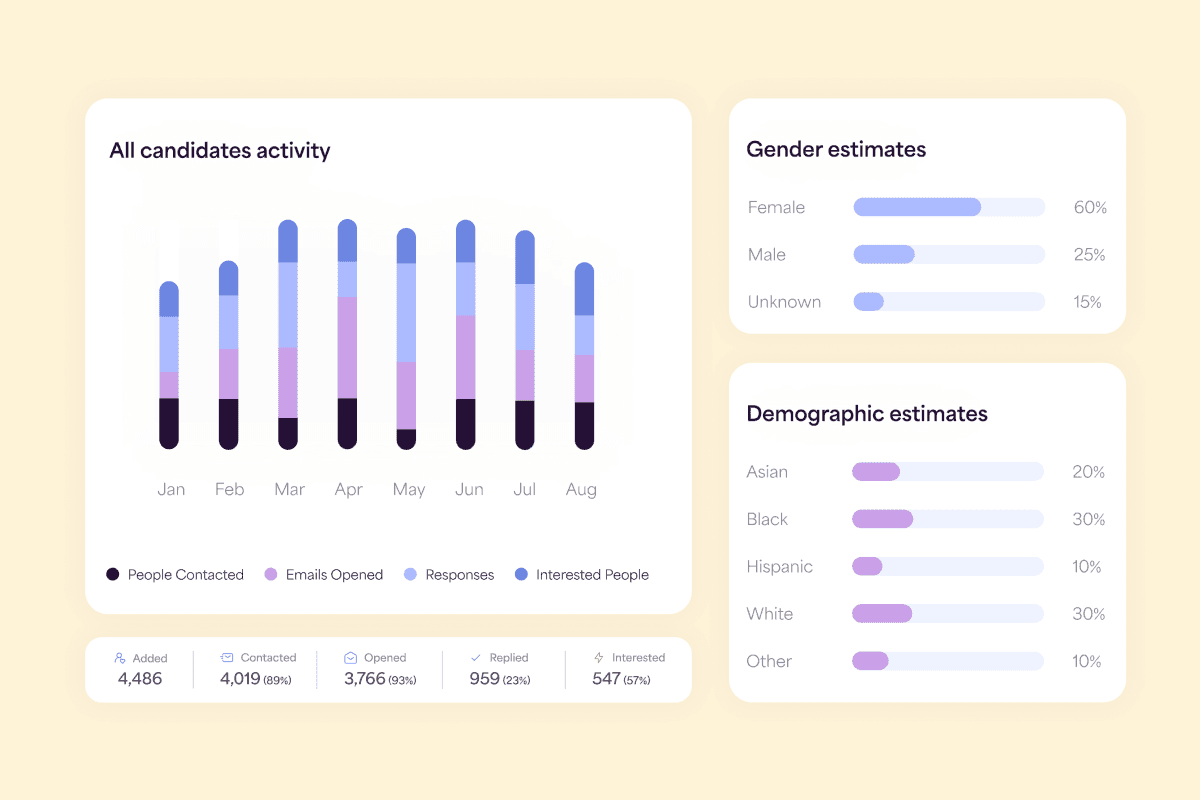Multiple open positions for specialized roles. Incomplete LinkedIn profiles. Candidates that don’t answer emails. The list of challenges a recruiter faces each day goes on and on, and in today’s competitive landscape, finding the right (interested) people for the job feels like a Herculean, yet highly repetitive, task.
As the saying goes, insanity is doing the same thing repeatedly and expecting a different result. It can lead to burnout among recruiters, which can have long-lasting effects on the individual and the organization.
So, how can you prevent or eliminate recruiter burnout?
Incorporating automation into your hiring process can help prevent burnout in the following significant ways:
Increase efficiency. 💪
On average, talent acquisition professionals spend nearly one-third of their workweek — about 13 hours — sourcing candidates for a single role. Incorporating automation into your sourcing process means much less time sifting through hundreds of unqualified or uninterested candidates and more time focused on creating a positive experience for qualified, interested candidates.

With candidate information automatically pulled in for you, automated recruiting through Fetcher also means you’ll stress less about tracking down social media links or making data entry errors because you’re rushing or dealing with screen fatigue.
Takeaway: Spend just 1-2 hours a week sourcing with automation vs. 13 hours with manual sourcing.
Save your organization money. 🤑
Market studies have revealed that the average job vacancy costs an organization $500 every day it remains unfilled. Because automated recruiting allows you to be actively hiring for multiple positions at once, you’ll shorten the hire time and lower the cost of vacancy.
For roles that are difficult to fill (like software developers), the average time to hire is already between 90-120 days. Fetcher’s automated recruiting platform has the potential to save your company at least $45,000 when you consider that your organization could be losing $500 a day for 90+ days!
Takeaway: Shorten your time to hire with recruiting automation, saving your company up to $45,000 in cost-of-vacancy dollars.
Understand the impact of your work quickly. 📈
There’s nothing more stressful than having to collect data last minute for your hiring manager or executive team. Recruiting platforms like Fetcher have built-in analytics, so measuring your performance is as easy as logging in and sharing your metrics.

You’ll spend less time collecting information and more time drawing insights that you can use to make improvements to your processes, along with educated recommendations for your team.
Takeaway: With built-in, real-time analytics, spend less time collecting metrics and more time improving processes based on the data at hand.
Devote more time to what you’re passionate about. 🤝
Most recruiters got into the field because they enjoy working with others, forming relationships, and connecting people with the right opportunities. Initial candidate outreach doesn’t fulfill these passions and is another time-consuming aspect of a recruiter’s job that automation can streamline.
With recruiting automation software like Fetcher, you can add candidates to an outreach email series with just a few clicks. And you don’t have to worry about searching your inbox for whether a candidate responded; Fetcher will keep track of that for you. That leaves more time for the more meaningful parts of hiring, like engaging with candidates and ensuring they have a positive first impression of your company.

Takeaway: Incorporating a recruitment automation platform into your tech stack makes the lives of recruiters easier and their repetitive tasks more streamlined, leading to hiring successes for the organization.
About Fetcher
Our mission is to help you engage talent that will transform your business aspirations into reality. Great talent is hard to find - that's why we offer a talent sourcing platform that not only gets your brand in front of the right candidates but also gives you a competitive edge in talent acquisition.
Begin building a relationship with your next great hire today and let Fetcher handle the rest. Learn more.




